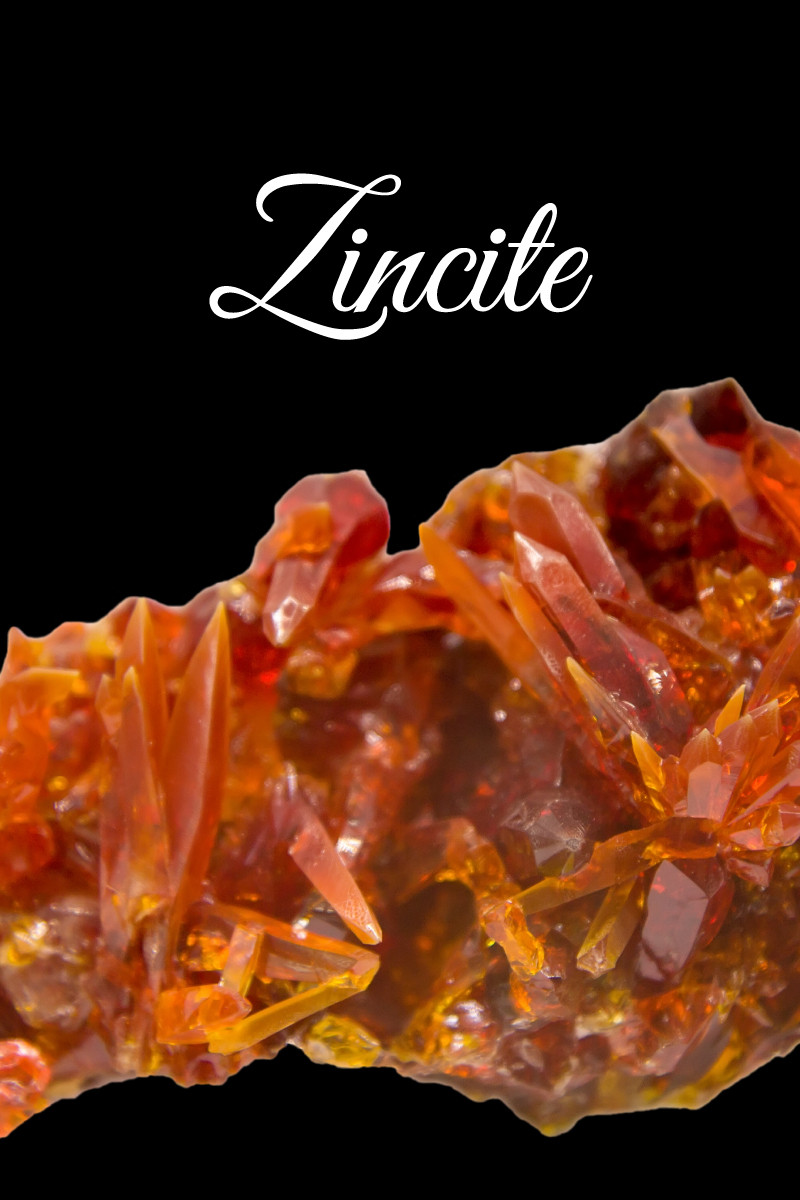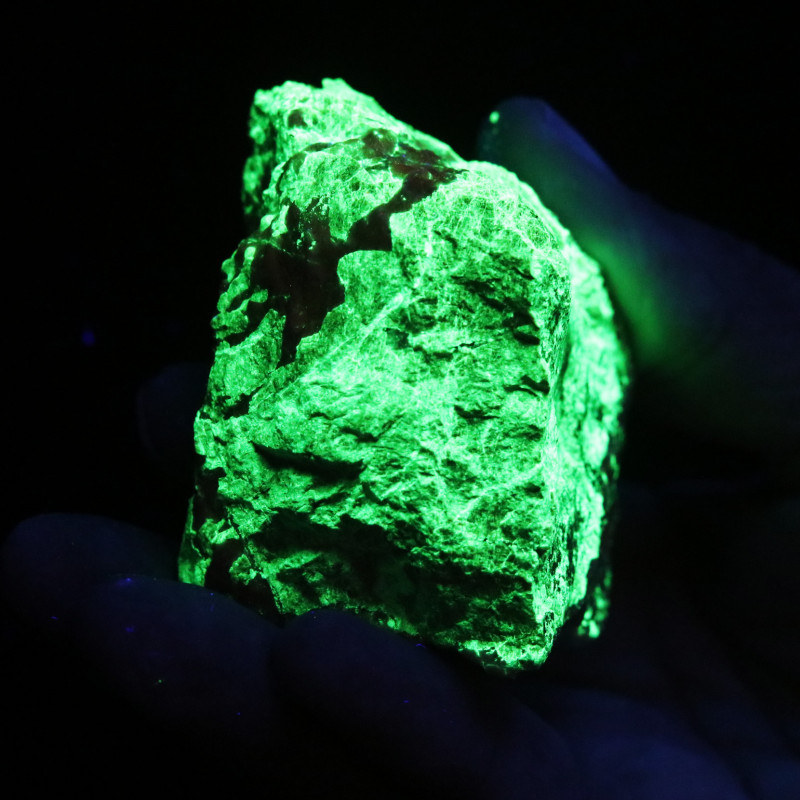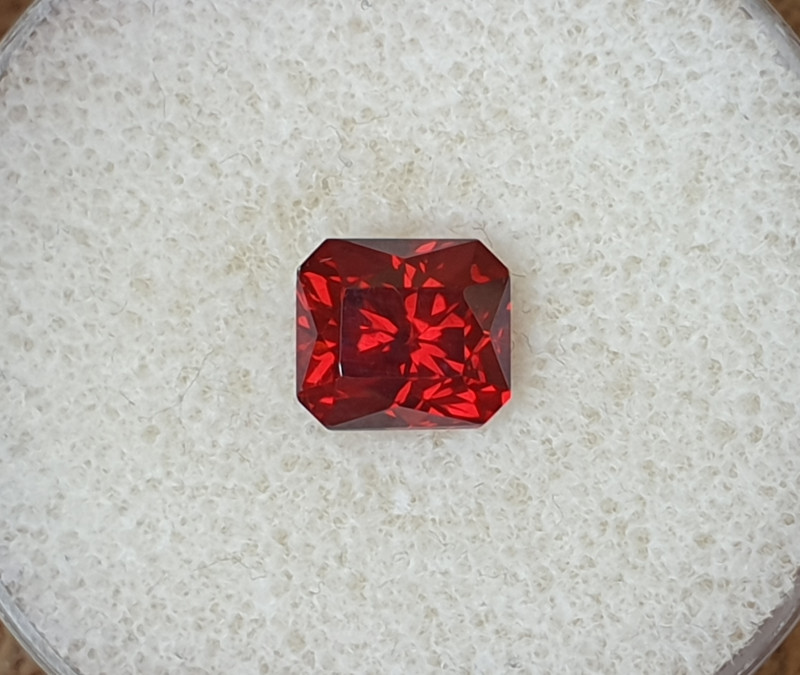
Pietra preziosa Zincite: proprietà, significati e informazioni sul valore
 La zincite è una pietra preziosa di ossido di zinco con sfumature autunnali. I cristalli naturali di qualità gemma provengono quasi esclusivamente dall'America , in particolare dallo stato del New Jersey. La maggior parte delle pietre preziose di zincite sul mercato sono sintetiche, poiché i cristalli naturali sono piccoli e rari.
La zincite è una pietra preziosa di ossido di zinco con sfumature autunnali. I cristalli naturali di qualità gemma provengono quasi esclusivamente dall'America , in particolare dallo stato del New Jersey. La maggior parte delle pietre preziose di zincite sul mercato sono sintetiche, poiché i cristalli naturali sono piccoli e rari.
La zincite è un minerale raro? La zincite naturale è molto rara, ad eccezione dei giacimenti del New Jersey. È anche difficile da tagliare in gemme, quindi le zinciti sfaccettate sono tra i reperti più rari. Fortunatamente per gli acquirenti, la zincite sintetica ha aperto un mercato più ampio per questa splendida pietra.
Di che colore è la zincite? La sua forma pura è incolore, ma questi colori sono rari. La zincite è nota per la sua caratteristica tonalità arancione brillante o rosso intenso, sebbene possa presentare anche altre tonalità autunnali, come il giallo, il marrone e, in rare occasioni, il verde.
Vuoi saperne di più? Vieni a scoprire tutti i significati, le proprietà curative, gli usi e molto altro della zincite!

Informazioni sulla pietra Zincite
La zincite è una pietra semipreziosa dalle qualità uniche. Astrologicamente, è una pietra zodiacale per Bilancia e Toro. Curiosamente, la zincite è anche un minerale lunare, portato sulla Terra nel 1976 dalla sonda sovietica Luna 24 durante la sua ultima missione sulla Luna.
Nel corso del tempo, questo minerale ha avuto numerosi nomi, tra cui:
Minerale/ossido di zinco rosso
ossido rosso di zinco
Calcozincite
Sterlingite/Stirlingite
Spartalite
Apartalite
Ancramite
Brucite
Zinco rubino
La zincite assomiglia spesso alla sfalerite , una pietra preziosa di solfuro di zinco, e potreste riconoscere il termine "rubino di zinco" come soprannome comune per la sfalerite. Tuttavia, "rubino di zinco" è anche un soprannome locale del New Jersey per la zincite.
La sfalerite è anche il minerale di zinco più importante, ma la zincite è un minerale di zinco? Sì! E questo è solo uno dei suoi numerosi usi al di fuori del mondo delle gemme.
Usi della zincite
La zincite di Franklin, nel New Jersey, è un minerale minore di ossido di zinco raffinato . Pur essendo il minerale più ricco di zinco della miniera, è il meno comune.
Un altro utilizzo è nelle creme solari . Tra i 17 ingredienti delle creme solari approvati dalla FDA, la zincite è speciale: blocca tutti i raggi UV (inclusi i dannosi UVA e UVB) e non danneggia la pelle sensibile. La percentuale ottimale di zincite è del 10-25%.
Infine, i cristalli di zincite (naturali e sintetici) sono stati storicamente utilizzati come rilevatori di semiconduttori nelle radio a cristallo per ripristinare o identificare i segnali radio.
Da un punto di vista minerale, di cosa è composta la zincite?
Specifiche e caratteristiche di Zincite
La formula della zincite pura è ZnO, ma le impurità di manganese sono così comuni che la formula viene spesso indicata come ZnO + Mn. In effetti, la zincite può contenere dall'1 al 7% di ossido di manganese. Anche le impurità di ferro sono comuni.
I cristalli di zincite sono emimorfi, ovvero le estremità presentano forme cristalline diverse, spesso una appuntita e una appiattita. I piccoli cristalli presentano anche facce piramidali (lati piatti) con striature orizzontali (solchi paralleli e dentellati). Possono anche essere deformati o corrosi.
I cristalli sono rari, quindi la zincite si presenta tipicamente in forma granulare o lamellare, massiva. Può anche presentarsi come drusa con una superficie ruvida e spesso una texture incisa.
Quali sono le proprietà della zincite? Scoprile tutte qui sotto:
Durezza Mohs : 4-4,5
Colore : tipicamente rosso intenso o arancione brillante; può essere incolore, giallo, rosso-brunastro o verde
Struttura cristallina : esagonale
Lucentezza : da sub-adamantina ad adamantina (simile al diamante) o resinosa
Trasparenza : da trasparente a opaco, solitamente traslucido
Indice di rifrazione : 2,01-2,03
Densità : 5,64-5,69
Scollatura : perfetta in 1 direzione su [1010] ma difficile; divisione basale su [0001]
Frattura : concoide, subconcoide o irregolare
Striscia : giallo-arancio
Luminescenza : molto raramente fluorescente - giallo in SW-UV; alcuni materiali del New Jersey (mescolati con altri minerali) sono fluorescenti - giallo-verde, giallo, giallo-arancio o arancione in SW-UV
Pleocroismo : A volte presente ma molto debole, due tonalità del colore del corpo
Vuoi sapere quali minerali rendono fluorescente la zincite? Continua a leggere per scoprirlo!
 Nella foto sopra: campione di willemite e calcite alla luce UV
Nella foto sopra: campione di willemite e calcite alla luce UV
Tipi di Zincite: sintetica e mista
La zincite non ha varietà vere e proprie, ma ce ne sono due tipi importanti da conoscere: la zincite sintetica e la zincite mescolata con franklinite e calcite.
Parleremo più approfonditamente della zincite sintetica nella sezione Proprietà delle pietre preziose.
Durante la formazione della zincite a Franklin, nel New Jersey (USA), spesso si mescola con franklinite, calcite e/o willemite. Franklinite, willemite e zincite sono i materiali contenenti zinco più significativi della miniera.
Ecco un ripasso degli altri tre:
Franklinite : ossido di ferro e zinco nero opaco, spesso con lucentezza metallica
Calcite : carbonato di calcio bianco con fluorescenza intensa in quasi tutti i colori, a volte più colori se la pietra è fasciata
Willemite : silicato di zinco tipicamente bianco o giallo-verdastro con intensa fluorescenza verde e talvolta forte fosforescenza
Quando la zincite si mescola con questi minerali, di solito si forma una base di calcite bianca (matrice) con macchie di franklinite e zincite. A volte questi campioni contengono anche willemite.
Quando in questa guida faremo riferimento a queste pietre, le chiameremo " zincite mista ".
La forma più comune di zincite è quella presente nei minerali di willemite o franklinite sotto forma di cristalli intergranulari, ovvero incastrati tra due o più cristalli più grandi e diversi.
Proprietà minerali? Fatto. Ma che dire delle proprietà metafisiche della zincite?

Significato e storia della zincite
La zincite simboleggia la rigenerazione, la resilienza e l'originalità. Rappresenta anche l'amicizia e il legame che si crea lavorando per un obiettivo comune.
Il nome "zincite" deriva dalla sua composizione in zinco. (Che sorpresa, vero?) La parola "zinco" deriva probabilmente dal tedesco zink, che significa "punta". Tuttavia, "zincite" non era il nome originario della pietra.
Il mineralogista americano Archibald Bruce scoprì la zincite nel New Jersey, negli Stati Uniti, nel 1810 e ne scrisse la prima descrizione minerale. Bruce chiamò la pietra "ossido rosso di zinco". Un altro mineralogista americano, Francis Alger, la soprannominò "sterlingite" nel 1844.
Il nome "zincite" venne coniato nel 1845 dal mineralogista austriaco Wilhelm Haidinger. Sebbene in seguito siano stati coniati altri nomi, come "spartalite" nel 1852 o "zinco rubino" nel 1861, il nome "zincite" rimase.
Oltre un secolo dopo, negli anni '80, la Polonia lanciò sul mercato americano una nuova zincite sintetica di qualità gemma. La creazione originale fu casuale, derivata da un sottoprodotto della produzione di polvere di ossido di zinco. Successivamente, altri replicarono il processo per immettere sul mercato opzioni di zincite più convenienti.
A cosa serve la zincite nella cristalloterapia?

Proprietà curative della zincite
Sia i cristalli di zincite naturale che quelli sintetici possono essere pietre curative , con poteri legati al loro colore. Ad esempio, la zincite rossa condivide le proprietà di altre gemme rosse , come quella di rinvigorire e rafforzare chi la indossa.
Nel frattempo, le gemme arancioni come la zincite arancione sono note per incoraggiare la creatività e il coraggio. Questi cristalli sono anche pietre chakra per il centro della creatività, il chakra del plesso solare, e per il centro del radicamento, il chakra della radice.
E che dire dei benefici fisici ed emotivi dei cristalli di zincite?
Guarigione fisica
Come il significato spirituale del cristallo di zincite, le presunte capacità curative della pietra includono il ripristino di forza ed energia. Allo stesso modo, si dice che aiuti a mantenere un regime di allenamento.
Guarigione Emotiva
Dal punto di vista emotivo, si ritiene che la zincite porti pace interiore ed equilibri le emozioni. I cristalloterapeuti consigliano di meditare con essa per manifestare i propri desideri.
Questo cristallo può anche aiutarti a trovare e abbracciare il tuo scopo unico, per poi perseguirlo senza paura. Dal punto di vista relazionale, la zincite incoraggia amicizie sane e genuine.
Stai pensando di cercare un cristallo curativo di zincite in vendita? Scopri quali fattori di valore considerare!

Proprietà della pietra preziosa Zincite
Oltre alla rarità, gli esperti valutano il valore della zincite in base a colore, taglio, purezza e peso in carati. Più avanti parleremo anche della zincite sintetica.
Colore
Sebbene l'arancione o il rosso siano i colori più comuni, la zincite può anche presentare diverse tonalità, come il rosso-brunastro, il giallo-arancio e, raramente, il verde. Anche la zincite gialla è rara, ma presenta la migliore dispersione (luccichio arcobaleno, o "fuoco").
La zincite a grana fine è in genere di colore più chiaro, mentre quella con microfratture mostra tipicamente tonalità più intense (ma opache). La zincite sintetica può essere di qualsiasi colore della zincite naturale, sebbene sia solitamente di colore brillante.
Il colore della zincite naturale deriva da impurità di manganese, ferro o entrambi. Il nichel causa la colorazione verde. L'origine del colore della zincite sintetica non è chiara. I ricercatori del Gemological Institute of America (GIA) ritengono che il colore possa derivare da fattori strutturali interni, non da impurità.
Taglio
La bassa durezza e la sfaldatura perfetta rendono la zincite difficile da tagliare, quindi la zincite sfaccettata è estremamente rara. Tuttavia, i gioiellieri spesso scelgono forme sfaccettate a cuscino radiante, quadrate o rettangolari.
Più spesso, viene venduta grezza o tagliata a cabochon . I cabochon più accattivanti (e più comuni) sono quelli di zincite mescolata a franklinite, calcite e willemite.
Chiarezza
La purezza della zincite (il numero di inclusioni visibili) è bassa, quindi la maggior parte delle pietre appare traslucida o opaca. Inclusioni comuni nelle pietre naturali sono l'eterolite nera o la franklinite.
Nella zincite sintetica polacca, i ricercatori hanno osservato interessanti inclusioni ovali e simili a girini. Si tratta molto probabilmente di fuliggine e gas carboniosi (anidride carbonica e metano) presenti durante il processo di fabbricazione.
Peso in carati e dimensioni
Tutti i cristalli di zincite di buona forma conosciuti hanno raggiunto solo 10 cm di diametro. La zincite massiccia, invece, può raggiungere diversi chili.
Per quanto riguarda il materiale tagliato, la maggior parte delle zinciti sfaccettate ha un peso di 1-3 carati, anche se le più grandi raggiungono i 20 carati. I cabochon di zincite del New Jersey possono arrivare a quasi 300 carati.
Sintetici
La maggior parte delle gemme di zincite sono sintetiche , ovvero create dall'uomo ma condividono la stessa composizione e struttura delle loro controparti naturali. Questi cristalli possono essere un sottoprodotto della fusione dello zinco o creati intenzionalmente in laboratorio.
Le inclusioni all'interno della zincite sintetica (discusse nella sezione "Chiarezza") sono più comuni nel materiale di scarto rispetto al materiale coltivato in laboratorio. Le tecniche utilizzate per la zincite creata in laboratorio possono essere la deposizione da vapore, il metodo idrotermale e il metodo Czochralski.

Formazione e fonti di zincite
La zincite può formarsi nelle rocce come minerale primario (formatosi durante la formazione della roccia) o come minerale secondario (formatosi in seguito attraverso l'azione degli agenti atmosferici o l'alterazione).
La zincite primaria si forma in corpi di minerali di zinco metamorfizzati (alterati) o calcarei. I giacimenti di minerali ricchi di zinco trasformati contengono anche zincite secondaria in aree ossidate, formata dall'ossidazione di minerali solfuri.
Gli scienziati non sono del tutto certi dell'esatto processo di formazione della zincite nel New Jersey. Molti concordano sul fatto che la zincite primaria si formi quando una roccia carbonatica contenente zinco, manganese e ferro subisce una decarbonatazione (alterazione dovuta ad alte temperature e pressione).
Alcuni ritengono che la zincite secondaria si formi quando la willemite subisce la serpentinizzazione (alterazione a bassa temperatura dovuta a reazioni chimiche).
Detto questo, dove si può trovare la zincite?
Luoghi di estrazione mineraria
Come sapete, il New Jersey (USA) è famoso per ospitare le miniere di zincite più abbondanti al mondo. Le due miniere più importanti del New Jersey sono Franklin e Sterling Hill, entrambe note per la loro abbondanza di minerali fluorescenti (sebbene la zincite da sola non sia fluorescente).
Inoltre, minuscoli granelli di zincite sono stati trovati in:
Arizona, Stati Uniti
Congo
Namibia
Spagna
Tasmania
Washington, Stati Uniti
La Polonia è stata il primo produttore di zincite sintetica e ne resta la fonte primaria.
Pronti ad acquistare la zincite in offerta? Allora parliamo di prezzo!

Prezzo e valore di Zincite
Mentre parliamo di prezzo al carato, tieni presente che la zincite è molto densa, quindi pesi in carati maggiori spesso implicano pietre di dimensioni inferiori. Per fare un paragone, una zincite da 1 carato sarebbe circa la metà delle dimensioni di un diamante da 1 carato.
La rarità della zincite naturale la rende più costosa della zincite sintetica. Le gemme di zincite naturale sfaccettata costano dai 40 ai 65 dollari al carato all'ingrosso, mentre le zincite sintetiche sfaccettate costano circa 10 dollari al carato.
I cabochon di zincite (non misti) costano circa 23 dollari al carato. I cabochon di zincite mista costano in genere 5-10 dollari ciascuno. I cristalli grezzi o i cluster di cristalli di zincite costano generalmente 0,20-2,50 dollari al carato.
I gioielli possono essere più costosi: le collane di cristallo di zincite vanno dai 30 ai 170 dollari.
Cura e manutenzione di Zincite
La cura adeguata della zincite inizia con la scelta di gioielli meno vulnerabili: pendenti e orecchini sono più al sicuro da eventuali danni. Gli anelli dovrebbero avere montature protettive .
Maneggia la zincite con cura e puliscila solo con acqua e, se necessario, con un sapone delicato. Tieni la pietra lontana dal calore e conservala in un luogo fresco, lontano dalle altre gemme.
Lasciati conquistare dalle energie rigeneranti di Zincite!
La zincite è una meraviglia rara, con quasi tanti nomi quanti sono i suoi benefici. La moderna invenzione della zincite sintetica ha reso queste bellezze molto più accessibili, con opzioni per tutte le tasche.
Se cerchi una gemma dai colori autunnali che porti rinnovamento e abbondanza durante tutto l'anno, la zincite è la pietra perfetta per te!
Cerca il Gemstone Encyclopedia
Aste correlate
articoli Correlati
Ognuno di noi ha una pietra preziosa che corrisponde al proprio segno zodiacale. Queste pietre sono anche note come la tua Pietra Stellare. Scopri di più su queste pietre e qual è la tua Pietra Stellare.
10th May 2018
In origine, le pietre portafortuna o gemme erano associate a un segno zodiacale o al mese di nascita di un individuo. Scopri qual è la tua pietra e guarda le pietre che abbiamo in vendita.
8th Feb 2021
Esistono moltissimi strumenti sul mercato per testare una pietra preziosa, ma quali sono i principali strumenti necessari per un'analisi semplice? Diamo un'occhiata a quattro strumenti per testare le pietre preziose.
4th Mar 2020
Articoli Recenti
Le sculture in avorio di palma, chiamato anche avorio vegetale, sono un'alternativa naturale all'avorio di elefante, ricavato in modo etico dalla noce della palma sudamericana Phytelephas. Scopri tutto sull'avorio di palma in questa guida!
15th Jan 2026
Le pietre a forma di fiore di crisantemo sono meraviglie naturali caratterizzate da un motivo floreale di calcite bianca, celestina o andalusite incastonato su calcare nero o argillite.
13th Jan 2026
La pietra del sole a reticolo arcobaleno è una varietà di feldspato con tre splendidi effetti ottici dovuti alla presenza di varie inclusioni. La sua colorazione infuocata e il suo motivo a reticolo la rendono una gemma rara da collezione!
12th Jan 2026
Categorie di articoli
How To's is where you will find helpful articles from gem Rock Auctions on how to cut gemstones, select gemstones and buy gemstones.
9 Articoli





